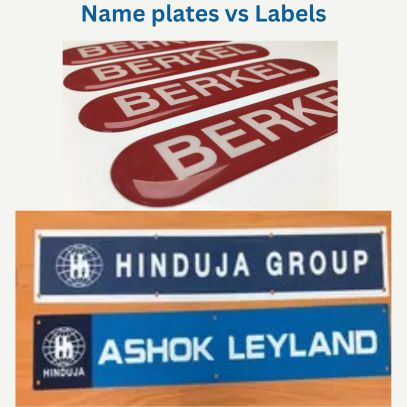In many industries, the use of name plates and labels cannot be done without identification, branding, and communication of crucial information. Identifying the fundamental differences between these two kinds of markers is critical for their efficient utilization and application in various contexts.
What is a Name plate?
Definition and Characteristics:
A name plate is a physical tag, generally made of materials like metal or heavy-duty plastics and usually containing a person’s name or the name of the product or a business. These markers typically show a sturdy construction to stand up to environmental conditions and are created to give permanent identification.
Uses and Applications:
Branding and Identification: Name plates are often used for branding; they are a physical manifestation of a company's identity on goods, machinery, equipment, or office spaces.
Industrial and Commercial Applications: These are applied widely in different sectors including automotive, manufacturing, aerospace, and construction where durable labels are a critical factor in asset management, safety procedures, and compliance protocols.
Decorative and Ornamental: Besides its functional role, nameplates are sometimes applied for ornamental purposes that increase the aesthetics of items of furniture, plaques, or trophies.

Definition and Characteristics:
A label is a small piece of material, usually paper, plastic film, cloth, or metal, that is stuck to a container, article, or surface. It usually has printed or written details of the components, utilization, destination, manufacturer, or other important facts. Labels are created to be readily applied and removed, thus providing convenience and flexibility to their use and application.
Uses and Applications:
Information and Instructional: Labels work as a way of giving essential information, instructions, or warnings about the products, packaging, or items. This data may consist of ingredients, usage rules, safety measures, and regulatory compliance information.
Product Identification: Labeling is commonly utilized in the retail and manufacturing industries for product identification, barcoding, and tracking among others. They help in inventory management, supply chain logistics, and retail merchandising.
Promotional and Branding: Additionally, labels are used for promotional purposes, displaying brand logos, slogans, or promotional messages on products, packaging, or marketing materials. They add to brand recognition and differentiation in the competitive market.
Organizational and Administrative: In office environments, labels are used for organization purposes like labeling files, folders, shelves, or any equipment. They facilitate workflows, increase efficiency, and guarantee proper classification of items.
Material Composition:
Name plates: Often made of long-lasting materials like metal (e.g., aluminum, stainless steel) or tough plastics (e.g., polycarbonate, acrylic). This material has a resistance to environmental factors such as corrosion, abrasion, and UV light exposure, thereby providing a long life and durability.
Labels: Varieties of materials based on use may be created from paper, plastic film, cloth, or metal foil. While labels may not all need the same degree of rigidity as nameplates, they still must be fit for the application.
Design and Purpose:
Name plates: Which is mostly used for branding, identification, and asset tagging. They normally have personalized designs such as inscribed or imprinted texts, logos, serial numbers, or QR codes which help with brand awareness and product recognition.
Labels: Used for passing on specific information, instructions, alerts, or warnings about the item or package they are on. Usually, labels have printed text, photographs, symbols, or barcodes which serve to communicate the most important details like what the product contains, the use instructions, the expiration date, and the safety precautions.
Placement and Functionality:
Name plates: Mechanically fastened to surfaces by means of mechanical fasteners (e.g., screws, bolts), adhesives, welding, or riveting. They are for permanent placement and may be too heavy for DIY (do-it-yourself) installation.
Labels: These are capable of being secured temporarily or semi-permanently using pressure-sensitive adhesives, ties, wraps, or sleeves. The labels offer flexibility in placement and removal, enabling easy installation and substitution when necessary. They can be used on a variety of surfaces, such as flat, round, or odd shapes which make them adaptable to several industries and applications.
Finally, the name plates and labels play different roles in their respective industries, varying significantly in terms of composition, design, purpose, and functionality. Name plates, fabricated from materials like metal and plastic, are usually focused on branding and identification. They are permanently attached with customized graphics. Conversely, labels offer material versatility, conveying information and warnings. They allow for temporary or semi-permanent attachment and flexible positioning.